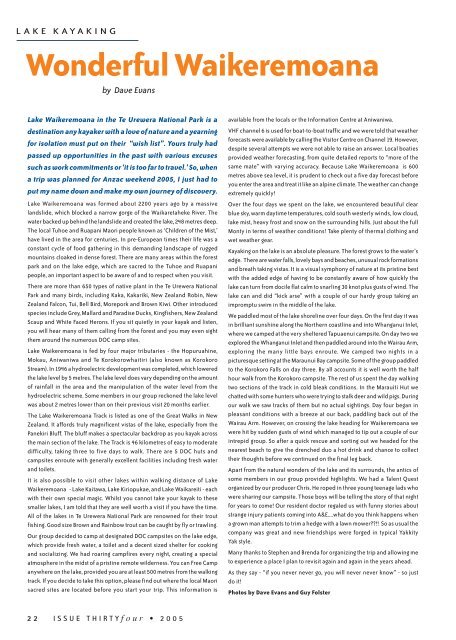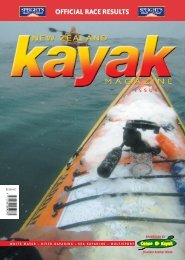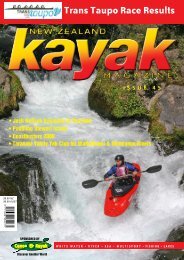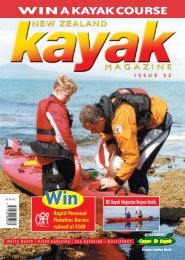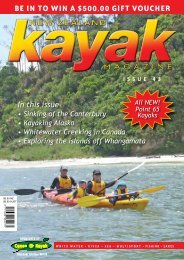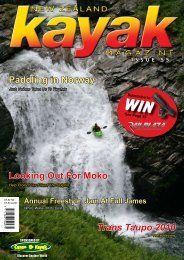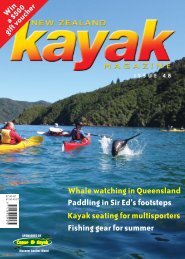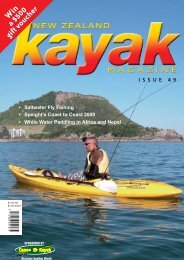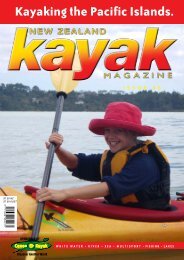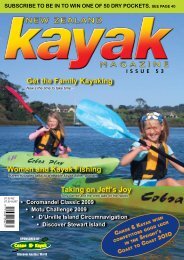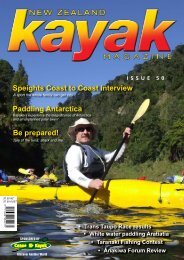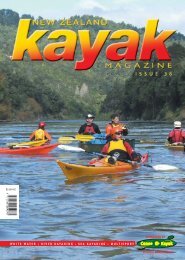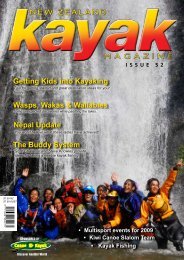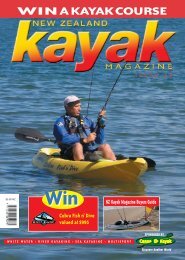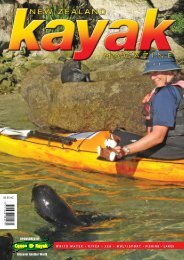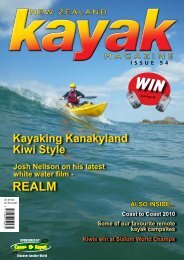C&K mag #34 dps-f spg - Canoe & Kayak
C&K mag #34 dps-f spg - Canoe & Kayak
C&K mag #34 dps-f spg - Canoe & Kayak
Create successful ePaper yourself
Turn your PDF publications into a flip-book with our unique Google optimized e-Paper software.
LAKE KAYAKING<br />
Wonderful Waikeremoana<br />
by Dave Evans<br />
Lake Waikeremoana in the Te Urewera National Park is a<br />
destination any kayaker with a love of nature and a yearning<br />
for isolation must put on their “wish list”. Yours truly had<br />
passed up opportunities in the past with various excuses<br />
such as work commitments or ‘it is too far to travel.’ So, when<br />
a trip was planned for Anzac weekend 2005, I just had to<br />
put my name down and make my own journey of discovery.<br />
Lake Waikeremoana was formed about 2200 years ago by a massive<br />
landslide, which blocked a narrow gorge of the Waikaretaheke River. The<br />
water backed up behind the landslide and created the lake, 248 metres deep.<br />
The local Tuhoe and Ruapani Maori people known as ‘Children of the Mist,’<br />
have lived in the area for centuries. In pre-European times their life was a<br />
constant cycle of food gathering in this demanding landscape of rugged<br />
mountains cloaked in dense forest. There are many areas within the forest<br />
park and on the lake edge, which are sacred to the Tuhoe and Ruapani<br />
people, an important aspect to be aware of and to respect when you visit.<br />
There are more than 650 types of native plant in the Te Urewera National<br />
Park and many birds, including Kaka, Kakariki, New Zealand Robin, New<br />
Zealand Falcon, Tui, Bell Bird, Morepork and Brown Kiwi. Other introduced<br />
species include Grey, Mallard and Paradise Ducks, Kingfishers, New Zealand<br />
Scaup and White Faced Herons. If you sit quietly in your kayak and listen,<br />
you will hear many of them calling from the forest and you may even sight<br />
them around the numerous DOC camp sites.<br />
Lake Waikeremoana is fed by four major tributaries - the Hopuruahine,<br />
Mokau, Aniwaniwa and Te Korokorowhaitiri (also known as Korokoro<br />
Stream). In 1946 a hydroelectric development was completed, which lowered<br />
the lake level by 5 metres. The lake level does vary depending on the amount<br />
of rainfall in the area and the manipulation of the water level from the<br />
hydroelectric scheme. Some members in our group reckoned the lake level<br />
was about 2 metres lower than on their previous visit 20 months earlier.<br />
The Lake Waikeremoana Track is listed as one of the Great Walks in New<br />
Zealand. It affords truly <strong>mag</strong>nificent vistas of the lake, especially from the<br />
Panekiri Bluff. The bluff makes a spectacular backdrop as you kayak across<br />
the main section of the lake. The Track is 46 kilometres of easy to moderate<br />
difficulty, taking three to five days to walk. There are 5 DOC huts and<br />
campsites enroute with generally excellent facilities including fresh water<br />
and toilets.<br />
It is also possible to visit other lakes within walking distance of Lake<br />
Waikeremoana - Lake Kaitawa, Lake Kiriopukae, and Lake Waikareiti - each<br />
with their own special <strong>mag</strong>ic. Whilst you cannot take your kayak to these<br />
smaller lakes, I am told that they are well worth a visit if you have the time.<br />
All of the lakes in Te Urewera National Park are renowned for their trout<br />
fishing. Good size Brown and Rainbow trout can be caught by fly or trawling.<br />
Our group decided to camp at designated DOC campsites on the lake edge,<br />
which provide fresh water, a toilet and a decent sized shelter for cooking<br />
and socializing. We had roaring campfires every night, creating a special<br />
atmosphere in the midst of a pristine remote wilderness. You can Free Camp<br />
anywhere on the lake, provided you are at least 500 metres from the walking<br />
track. If you decide to take this option, please find out where the local Maori<br />
sacred sites are located before you start your trip. This information is<br />
22 ISSUE THIRTYfour • 2005<br />
available from the locals or the Information Centre at Aniwaniwa.<br />
VHF channel 6 is used for boat-to-boat traffic and we were told that weather<br />
forecasts were available by calling the Visitor Centre on Channel 19. However,<br />
despite several attempts we were not able to raise an answer. Local boaties<br />
provided weather forecasting, from quite detailed reports to “more of the<br />
same mate” with varying accuracy. Because Lake Waikeremoana is 600<br />
metres above sea level, it is prudent to check out a five day forecast before<br />
you enter the area and treat it like an alpine climate. The weather can change<br />
extremely quickly!<br />
Over the four days we spent on the lake, we encountered beautiful clear<br />
blue sky, warm daytime temperatures, cold south westerly winds, low cloud,<br />
lake mist, heavy frost and snow on the surrounding hills. Just about the full<br />
Monty in terms of weather conditions! Take plenty of thermal clothing and<br />
wet weather gear.<br />
<strong>Kayak</strong>ing on the lake is an absolute pleasure. The forest grows to the water’s<br />
edge. There are water falls, lovely bays and beaches, unusual rock formations<br />
and breath taking vistas. It is a visual symphony of nature at its pristine best<br />
with the added edge of having to be constantly aware of how quickly the<br />
lake can turn from docile flat calm to snarling 30 knot plus gusts of wind. The<br />
lake can and did “kick arse” with a couple of our hardy group taking an<br />
impromptu swim in the middle of the lake.<br />
We paddled most of the lake shoreline over four days. On the first day it was<br />
in brilliant sunshine along the Northern coastline and into Whanganui Inlet,<br />
where we camped at the very sheltered Tapuaenui campsite. On day two we<br />
explored the Whanganui Inlet and then paddled around into the Wairau Arm,<br />
exploring the many little bays enroute. We camped two nights in a<br />
picturesque setting at the Maraunui Bay campsite. Some of the group paddled<br />
to the Korokoro Falls on day three. By all accounts it is well worth the half<br />
hour walk from the Korokoro campsite. The rest of us spent the day walking<br />
two sections of the track in cold bleak conditions. In the Marauiti Hut we<br />
chatted with some hunters who were trying to stalk deer and wild pigs. During<br />
our walk we saw tracks of them but no actual sightings. Day four began in<br />
pleasant conditions with a breeze at our back, paddling back out of the<br />
Wairau Arm. However, on crossing the lake heading for Waikeremoana we<br />
were hit by sudden gusts of wind which managed to tip out a couple of our<br />
intrepid group. So after a quick rescue and sorting out we headed for the<br />
nearest beach to give the drenched duo a hot drink and chance to collect<br />
their thoughts before we continued on the final leg back.<br />
Apart from the natural wonders of the lake and its surrounds, the antics of<br />
some members in our group provided highlights. We had a Talent Quest<br />
organized by our producer Chris. He roped in three young teenage lads who<br />
were sharing our campsite. Those boys will be telling the story of that night<br />
for years to come! Our resident doctor regaled us with funny stories about<br />
strange injury patients coming into A&E....what do you think happens when<br />
a grown man attempts to trim a hedge with a lawn mower??!! So as usual the<br />
company was great and new friendships were forged in typical Yakkity<br />
Yak style.<br />
Many thanks to Stephen and Brenda for organizing the trip and allowing me<br />
to experience a place I plan to revisit again and again in the years ahead.<br />
As they say - “if you never never go, you will never never know” - so just<br />
do it!<br />
Photos by Dave Evans and Guy Folster


